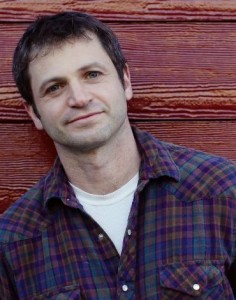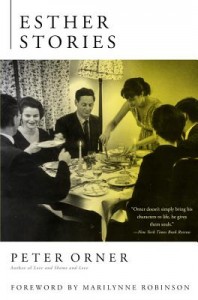
Photo by Traci Griffin Treat
Up in a small town in New Hampshire, at the end of the summer, I sat down with Peter Orner’s most recent collection of short stories, Last Car Over The Sagamore Bridge (Little, Brown and Company). The book connects characters and stories from the haunted world of Fall River Massachusetts, to the blue collar inner workings of Jewish family life in Chicago, to Russia and the Czech Republic. The collection confronts the meaning of silence in our often overburdened world, questions the nature of our own isolation, and drives at the very reasons why we tell stories, sometimes again and again, sometimes for the first time.
Orner’s deep connection to place drew me in. In a way, these characters seem to exist in two places at once: the physical world to which they belong, and the world in which they created inside of their own minds. By capturing the heartache found in the recesses of man’s interior worlds, characters in this collection can be found obsessing over their own pasts, losses, and longings in exchange with the struggles of their present everyday realities. Orner balances very short stories with occasional longer narrative arcs, both bordering on eerie and surprising. A feeling of urgency often takes hold under the breath of fast moving narrators willing to share sudden secrets while unfolding their tales. Some of the stories read like bare bones as Orner strips away at the loudness of language, soldering it down to the simple and necessary. Many of these stories rally between the comedic and the tragic. A woman slowly reveals the memory of another’s uncanny suicide, a restaurant burns down, a man sits alone and observes his grief, an ex-murderer decides to respond to his hate mail.
The book reads like a beautifully smashed mirror, each piece intricate to the whole. The stories barely brush one another. And although the collection in its entirety is broken up into sections, it is Orner’s ability to find the extraordinary in the ordinary that weaves this collection together.
This September, I sat down with Peter Orner over two cups of steaming black coffee in Ann Arbor, one of his long lost homes, to discuss Last Car Over The Sagamore Bridge.
Peter Orner was born in Chicago and now lives in San Francisco. He is the author of the acclaimed novels Love and Shame and Love (Little, Brown and Company, 2011) and The Second Coming of Mavala Shikongo (Little, Brown and Company, 2006). Orner is also the editor of two books of oral history: Underground America (McSweeney’s, 2008) and Hope Deferred: Narratives of Zimbabwean Lives (McSweeney’s, 2010). His short story collection, Esther Stories (Mariner Books, 2001), has recently been re-released by Little Brown with a new introduction by Marilynne Robinson. Peter Orner has been awarded two Pushcart Prizes. He was the recipient of a Guggenheim Fellowship in 2006. His “Lonely Voice” column on the short story can be found on The Rumpus.
Interview:
 Nina Buckless: In the title story “Last Car Over the Sagamore Bridge,” we discover that Walt Kaplan is sitting in the unquiet of his study. It seems that this piece has captured what silence means for Walt Kaplan. How do you get at writing silence into a piece of fiction and what does silence mean for you as a writer?
Nina Buckless: In the title story “Last Car Over the Sagamore Bridge,” we discover that Walt Kaplan is sitting in the unquiet of his study. It seems that this piece has captured what silence means for Walt Kaplan. How do you get at writing silence into a piece of fiction and what does silence mean for you as a writer?
Peter Orner: Writing silence is what I’m always, always trying to do. It means everything to me. The world is so loud? Don’t you feel this way sometimes? It might be why my stuff is becoming increasingly shorter. I try and capture what I see as the silence between sentences, the silences between stories. And too much of what I read is as noisy as the world. Maybe I’m just trying to quiet things down a little. I think my characters, particularly in Walt’s case, are trying to be quiet in a world that won’t stop talking. But it’s not just the world, his mind too, like everybody else’s, is racing. So the noise isn’t only from outside, it is inside too. So Walt really isn’t silent at all. This is his real problem. How to make our brains silent too? But the silence inside Walt’s mind is of a different sort than the noise outside, if this makes any sense. It’s this weird noisy silence of the mind that I’m after as well. Does that make any sense?
And yet to someone observing Walt from the exterior it would appear that he is sitting in a quiet, silent moment in his study.
Yes, on the exterior he looks like he is quiet but in the interior, like I say, there’s a lot of disquiet. For me, there’s a great deal of action when someone is just sitting and thinking. I’ve got a number of stories like this, I call them kitchen table stories, as someone’s sitting at the kitchen table thinking—that’s plot right there, that’s action. Think of how many monumental things in our lives are decided in the silence of a kitchen table.
Whether silence actually exists or not for us and what it may or may not mean to truly be silent?
Yes, exactly. This question of being truly silent. I like that. I think a lot of us are trying to get to it and never getting there. But it’s all about the trying. Some of my characters, like Walt, haven’t given up hope that they’ll find it. But since Walt is morbid—he knows there’s the silence he wants and maybe knows he can never have, and that other silence, that of the grave, that he knows he’ll have a lot of down the line.
I also felt the interruption of Walt’s silence by the “thump thump” of his daughter, or the interruptions from his wife on the phone.
Right, his wife and kid are noisy as all hell, but by the end of the story he comes to love these interruptions. They’re actually his life, you know what I mean?
And he too interrupts his own quest for silence by talking to his wife without talking to her…
True, I for one do this a lot. Don’t you? Talk to people who aren’t there? In Walt’s case, his wife is in the kitchen but still he talks to her in his head rather than in person. That’s the kind of guy he is.
In your work, what I would refer to as home resurfaces as a place that some of your characters might be attempting to get back to. I found much of this collection shaped by such places which resurface time and again in the collection. Chicago and Fall River, for example.
 I am always thinking about where my characters think they belong. I am from Chicago and though I no longer live there, I spend much of my day, most days, back there in my mind. Lake Michigan is the physical touchstone of my life. I look at the Pacific Ocean and I think, damn if it was only smaller and had more industry. My mother is from Fall River, Massachusetts. I spent my summers in Fall River and it is a very strange and beautiful town. It’s heyday was in the 1850’s when it was called “Spindle City.” It has seen better days. It has seen better days for a hundred years. Tomorrow will always be better in Fall River. That’s what I like about it. It is a city that is perpetually trying to regain lost glory. A good metaphor for us all. I’m interested in how place shapes character. Sometimes place is the only thing that people have to hold on to, their connection to a city, to a piece of land. But even so, even when we are in that place that is supposed to be home, why do we still feel alienated? Walt Kaplan never leaves Fall River. He is still always looking for it. Because the true home might not quite exist, at least for a guy like him.
I am always thinking about where my characters think they belong. I am from Chicago and though I no longer live there, I spend much of my day, most days, back there in my mind. Lake Michigan is the physical touchstone of my life. I look at the Pacific Ocean and I think, damn if it was only smaller and had more industry. My mother is from Fall River, Massachusetts. I spent my summers in Fall River and it is a very strange and beautiful town. It’s heyday was in the 1850’s when it was called “Spindle City.” It has seen better days. It has seen better days for a hundred years. Tomorrow will always be better in Fall River. That’s what I like about it. It is a city that is perpetually trying to regain lost glory. A good metaphor for us all. I’m interested in how place shapes character. Sometimes place is the only thing that people have to hold on to, their connection to a city, to a piece of land. But even so, even when we are in that place that is supposed to be home, why do we still feel alienated? Walt Kaplan never leaves Fall River. He is still always looking for it. Because the true home might not quite exist, at least for a guy like him.
That home might be remembrances, connections, glimpses, pockets of hidden moments in stories.
I think so, yes, that there’s no one home. But it may appear in memory, in, like you say, pockets of hidden moments. Hey, that’s a good title: “Pockets of Hidden Moments.”
Some of your characters appear to be mulling over something or holding onto something that may be difficult to let go of. I am thinking of the Chicago Slayer, who feels the need to read and answer letters; Stace from “Spokane,” who suddenly tells a story she needs to tell; Gerlado with his fascination for Al Capone’s history; and even Rosalie from “Herb and Rosalie Swanson at the Cocoanut Grove.” What is it about such characters that motivates you?
Those characters you mention are in some kind of isolation. I like to look at people in that frame of mind. And yet most of these people, with the exception of Nathan Leopold, the Chicago killer, aren’t actually alone. I’m very interested in how people are isolated even when they’re with other people. And this idea of mulling something over, yes, my characters are often people who can’t let go of something in their pasts. They often need to unburden themselves through a story. Whether these stories are true or not is often not the issue, but there’s something they need to say, something they’ve got to get rid of.
How do you wrestle with your characters as the torch bearers of lost places often reshaped by time? Places that exist remembered only by them?
There’s a Robert Creeley poem where a guy is giving someone directions to a place based on what is no longer there. A line goes something like: “Turn right at where the old Maple used to be.” In a way, I am giving directions to readers based on things that aren’t there anymore.
How does understanding the meaningfulness of a character’s job help you figure out where they may fit into a story among other characters?
Or where they don’t fit in.
Yes, or how they don’t fit in.
A weird thing. So many people end up spending most of our lives doing something they’re not sure they should be doing in the first place. I find that a lot of my characters are in that boat. Walt Kaplan sells furniture. He sells furniture because his father sold furniture. In many ways this defines him. But not totally. He’s a man who also lives a very vibrant imaginative life through the books he never stops reading. So we aren’t defined by our jobs I guess is what I’m saying, more by what our preoccupations are. And our histories.
 You have a character who is a bookbinder as well, Sam Koplovitz from the story “Waldheim.”
You have a character who is a bookbinder as well, Sam Koplovitz from the story “Waldheim.”
My great grandfather was a bookbinder. Apparently he was well known in Chicago for binding books, back in the twenties. I’ve looked into it, hard work, kind of like being a cobbler only much tougher on the hands. I think about him, this man I never knew, my great-grandfather. Not much is known about him. What’s been handed down about him are two things: 1) he was a bookbinder, and 2) he loved horses. This is all I know. But it’s a start, you know, the start of a character. This is where I begin sometimes, with just a sliver of something.
You also have characters like Horace and Josephine, who are defined by a beautiful vision that the other characters cling to.
Yes, stories come this way too. A beautiful vision of great worldly couple—but it was also a fraudulent vision. Horace and Josephine’s reputation, among family and among friends, was based on Horace’s stealing other people’s money. But at the end of the day, we got to be known for something. So what if Horace went broke and was disgraced? He’s a story now, one for the ages, one that people will repeat for as long as anybody is around to remember. You remember Horace and Josephine, how sophisticated they were before it all went bust?
How does imagination and gossip meet in your mind?
Eudora Welty spoke wonderfully about gossip. She talked about it as the lifeblood of her work. I think that in a funny and terrible way, because gossip can be pretty deadly, I pay attention to what people gossip about because there’s usually, but not always, good stories behind that talk somewhere. Those are the ones that get told and told and told, which I am always interested in. I always gravitate to the stories that people tell and re-tell. And gossip has a way of being told and retold. And who doesn’t stop and listen to gossip? There are pious people who say, “Oh, I don’t like gossip,” but then they always listen to it. The ones who don’t want to gossip are often the most gossipy.
And if not then they are also gossiping in their head.
Right, it is almost like the word doesn’t exactly fit how big a thing gossip actually is. If you think about it, what is bigger? When a story starts to literally move from person to person. That’s powerful. You know, Monica Lewinsky, that might have started as gossip in the office. Monica needed somebody to tell. She needed to tell Linda Tripp. Maybe it just started as innocent gossip and then it went into a national security matter? So, I find that it’s an incredibly invaluable tool for us as writers. Dangerous stuff, of course, and to be handled with care.
What draws you to writing about so many different sorts of characters?
Ann Arbor is a small town but not that small. Imagine if you knew everybody here? I mean every single person. Out of, what, a hundred thousand? More probably. How many people live here? Anyway, how mind-blowing that would be? William James once said—and for the life of me I can’t track down this quote, but I swear I read it somewhere—“If you were able to hold in your head all of the personal drama of all of the people in one city then your head would explode.”
Further Links and Resources:
- For more on Peter Orner and his work, please visit the author’s website.
- You can also check out his “Lonely Voice” column for The Rumpus.
- Hear Peter Orner read “Herb and Rosalie Swanson at the Cocoanut Grove,” the first installment in BOMB’s Fiction for Driving Across America series.
- Read Nina Buckless’s 2012 interview with Jim Krusoe.





